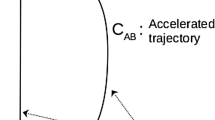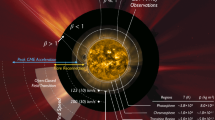Abstract
Based on the data obtained with the CHIMERA algorithm, we consider the evolution of a long-lived low-latitude coronal hole during its central meridian passage over the period from February 15, 2012, to October 14, 2012. The correlation coefficient between the photospheric magnetic field strength of the coronal hole and its area in nine Carrington rotations is \(R={-}0.55\). It differs noticeably from \(R={-}0.82\) given in Heinemann et al. The results suggest a significant dependence of the area of coronal holes on the method of determining their boundaries. This can have a noticeable effect both on the prediction of geomagnetic activity and on the understanding of the nature of solar phenomena related to these structures.




Similar content being viewed by others
REFERENCES
S. A. Aivazyan, Statistical Study of Dependences (Metallurgiya, Moscow, 1968) [in Russian].
Z. S. Akhtemov and Yu. T. Tsap, Geomagn. Aeron. 58, 1149 (2018).
Z. S. Akhtemov, Y. T. Tsap, and V. I. Haneychuk, Astrophysics 63, 399 (2020).
S. Akiyama, N. Gopalswamy, S. Yashiro, and P. Makela, Publ. Astron. Soc. Jpn. 65, S15 (2013).
I. A. Bilenko and K. S. Tavastsherna, Geomagn. Aeron. 57, 803 (2017).
R. J. Bray and R. E. Loughhead, Sunspots (Chapman and Hall, London, 1964).
S. R. Cranmer, Space Sci. Rev. 101, 229 (2002).
S. R. Cranmer, Liv. Rev. Solar Phys. 6, 3 (2009).
K. Fujiki, M. Tokumaru, T. Iju, K. Hakamada, and M. Kojima, Solar Phys. 290, 2491 (2015).
T. M. Garton, P. T. Gallagher, and S. A. Murray, J. Space Weather Space Climate 8, 02 (2018).
V. S. Gmurman, Probability Theory and Mathematical Statistics (Vysshaya Shkola, Moscow, 1972) [in Russian].
S. G. Heinemann, S. J. Hofmeister, A. M. Veronig, and M. Temmer, Astrophys. J. 863, 29 (2018).
S. J. Hofmeister, A. Veronig, M. A. Reiss, M. Temmer, S. Vennerstrom, B. Vrsnak, and B. Heber, Astrophys. J. 835, 268 (2017).
S. J. Hofmeister, D. Utz, S. G. Heinemann, A. Veronig, and M. Temmer, Astron. Astrophys. 629, A22 (2019).
M. Kojima, M. Tokumaru, K. Fujiki, H. Itoh, T. Murakami, and K. Hakamada, in New Solar Physics with Solar-B Mission, Ed. by K. Shibata, S. Nagata, and T. Sakurai, ASP Conf. Ser. 369, 549 (2009).
D. F. Kong, G. M. Pan, X. L. Yan, J. C. Wang, and Q. L. Li, Astrophys. J. 863, L22 (2018).
J. R. Lemen, A. M. Title, D. J. Akin, P. F. Boerner, C. Chou, J. F. Drake, D. W. Duncan, Ch. G. Edwards, et al., Solar Phys. 275, 17 (2012).
Y. A. Nagovitsyn, A. A. Pevtsov, and A. A. Osipova, Astron. Nachr. 338, 26 (2017).
J. T. Nolte, A. S. Krieger, A. F. Timothy, R. E. Gold, E. C. Roelof, G. Vaiana, A. J. Lazarus, and J. D. Sullivan, Solar Phys. 46, 303 (1976).
V. N. Obridko and Yu. A. Nagovitsyn, Solar Activity, Cyclicity, and Prediction Methods (VVM, St. Petersburg, 2017) [in Russian].
T. Rotter, A. M. Veronig, M. Temmer, and B. Vrsnak, Solar Phys. 281, 793 (2012).
J. Saqri, A. M. Veronig, S. G. Heinemann, S. J. Hofmeister, M. Temmer, K. Dissauer, and Y. Su, Solar Phys. 295, 6 (2020).
R. N. Shelke and M. C. Pande, Bull. Astron. Soc. India 12, 404 (1984).
Yu. S. Shugai, I. S. Veselovsky, and L. D. Trichtchenko, Geomagn. Aeron. 49, 415 (2009).
Y.-M. Wang, Astrophys. J. 715, L121 (2010)
Y.-M. Wang and N. R. Sheeley, Astrophys. J. 355, 726 (1990).
Yu. I. Yermolaev, I. G. Lodkina, N. S. Nikolaeva, M. Yu. Yermolaev, M. O. Riazantseva, and L. S. Rakhmanova, J. Atmos. Sol.-Terr. Phys. 180, 52 (2018).
ACKNOWLEDGMENTS
We are grateful to the referees for their careful reading of the paper and their useful remarks, which contributed significantly to its improvement. This work was supported in part by the Russian Foundation for Basic Research (project no. 20-52-26006) and the Ministry of Education and Science (NIR no. 0831-2019-0006).
Author information
Authors and Affiliations
Corresponding author
Additional information
Translated by V. Astakhov
Rights and permissions
About this article
Cite this article
Akhtemov, Z.S., Tsap, Y.T. On the Relationship between the Magnetic Field of a Low-Latitude Coronal Hole and Its Area. Astron. Lett. 47, 117–122 (2021). https://doi.org/10.1134/S1063773721010011
Received:
Revised:
Accepted:
Published:
Issue Date:
DOI: https://doi.org/10.1134/S1063773721010011




